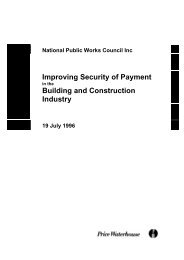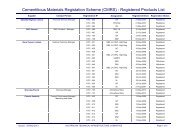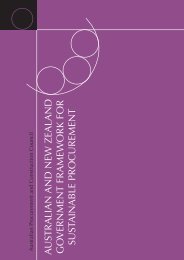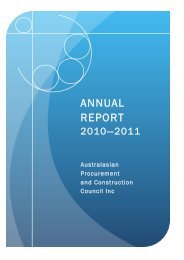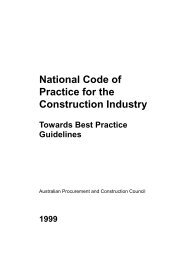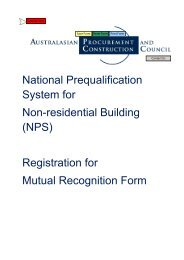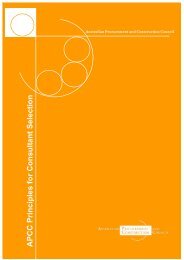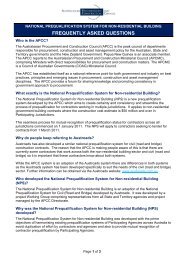ESD design guide for Australian Government buildings: Edition 2
ESD design guide for Australian Government buildings: Edition 2
ESD design guide for Australian Government buildings: Edition 2
You also want an ePaper? Increase the reach of your titles
YUMPU automatically turns print PDFs into web optimized ePapers that Google loves.
glossary<br />
glossary<br />
Fuel Cells<br />
Used in electrical generation. This is an<br />
apparatus used <strong>for</strong> combining fuel and<br />
oxides to generate electricity. It is the<br />
conversion of chemicals to electrical<br />
energy. (Energy Australia www.energy.<br />
com.au).<br />
G<br />
Global warming potential (GWP)<br />
GWP is a measure of how much a given<br />
mass of greenhouse gas is estimated to<br />
contribute to global warming. It is a relative<br />
scale which compares the gas in question<br />
to that of the same mass of carbon dioxide<br />
whose GWP is one. An exact definition<br />
can be found at the IPCC web site.<br />
Examples of the GWP of gases are as<br />
follows:<br />
• carbon dioxide has a GWP of exactly<br />
1 (since it is the baseline unit to<br />
which all other greenhouse gases are<br />
compared.)<br />
• methane has a GWP of 21<br />
• nitrogen dioxide has a GWP of 310<br />
• Some hydrofluorocarbon (HFC)<br />
compounds have GWPs of several<br />
thousands (HFC-23 is 11,700).<br />
Greenfield Site<br />
Land on which no development has<br />
previously taken place. Usually on the<br />
periphery of an existing built-up area.<br />
(Corus Construction Centre glossary,<br />
http://www.corusconstruction.com/page_<br />
9041.htm).<br />
Greenhouse gases<br />
Gases which contribute to global warming<br />
by preventing the outward radiation of<br />
heat from the Earth which increases the<br />
atmosphere’s absorption of sunlight<br />
(the greenhouse effect). Greenhouse<br />
gases are measured in carbon dioxide<br />
equivalent units. Some greenhouse<br />
gases are naturally occurring (water<br />
vapour, carbon dioxide, methane, nitrous<br />
oxide and ozone). Others result from<br />
human activities, the most powerful of<br />
which are: hydrofluorocarbons (HFCs),<br />
perfluorocarbons (PFCs) and sulphur<br />
hexafluoride (SF6). (Property Council of<br />
Australia, Sustainable Development Guide,<br />
2001).<br />
Green lease schedule<br />
A lease schedule that sets out the mutual<br />
obligation <strong>for</strong> building owners, managers<br />
and tenants regarding environmental<br />
per<strong>for</strong>mance.<br />
Green power<br />
Electricity generated from clean renewable<br />
sources, such as the sun, wind, water and<br />
organic matter. The electricity is bought<br />
by energy suppliers on behalf of their<br />
customers. (Property Council of Australia,<br />
Sustainable Development Guide, 2001).<br />
Green Star<br />
Green Star was developed and funded<br />
by industry and government. Green<br />
Star’s framework brings existing tools<br />
and standards together under one<br />
unified system. Green Star rating tools<br />
are relevant to building type, phase of<br />
development cycle and geographical<br />
location. Green Star awards points <strong>for</strong><br />
best practice initiatives and, as such,<br />
projects that receive a Green Star Certified<br />
Rating have demonstrated leadership and<br />
are considered to be in the top quartile of<br />
the market. Green Star rating tools are<br />
being released <strong>for</strong> all building types (office,<br />
retail, education, health, residential etc.).<br />
Groundwater<br />
Water within the earth that supplies<br />
wells and springs; water in the zone of<br />
saturation where all openings in rocks and<br />
soil are filled, the upper surface of which<br />
<strong>for</strong>ms the water table. (Property Council of<br />
Australia, Sustainable Development Guide,<br />
2001).<br />
H<br />
Hydro-chlorofluorocarbons (HCFCs)<br />
HCFCs were used as the original<br />
replacement <strong>for</strong> CFCs and are still<br />
commonly used. HCFCs, like CFCs,<br />
cause ozone depletion, but to a lesser<br />
extent. HCFCs are being phased out<br />
under the Montreal Protocol. (Melbourne<br />
Docklands <strong>ESD</strong> Guide, Oct 2002).<br />
Hydro fluorocarbons (HFCs)<br />
Transitional replacements <strong>for</strong> CFCs, they<br />
are also greenhouse gases. (Property<br />
Council of Australia, Sustainable<br />
Development Guide, 2001).<br />
HVAC systems<br />
The equipment, distribution network and<br />
terminals that provide either collectively<br />
or individually the processes of heating,<br />
ventilation or air-conditioning to a building.<br />
(Property Council of Australia, Sustainable<br />
Development Guide, 2001).<br />
I<br />
Intergovernmental Panel on Climate<br />
Change (IPCC)<br />
The IPCC was established in 1988 by two<br />
United Nations organizations, the World<br />
Meteorological Organization (WMO)<br />
and the United Nations Environment<br />
Programme (UNEP) to assess the “risk<br />
of human-induced climate change”. The<br />
Panel is open to all members of the WMO<br />
and UNEP.<br />
Its reports are widely cited and have<br />
been highly influential in <strong>for</strong>ming national<br />
and international responses to climate<br />
change, yet some of the scientists whose<br />
work is summarized in these reports have<br />
accused the IPCC of bias.<br />
Indoor air quality (IAQ)<br />
Includes the introduction and distribution<br />
of adequate ventilation air, control of<br />
airborne contaminants and maintenance<br />
of acceptable temperature and relative<br />
humidity. (Property Council of Australia,<br />
Sustainable Development Guide, 2001).<br />
Indoor environment quality (IEQ)<br />
This factor describes the cumulative<br />
effects of indoor air quality, lighting<br />
and thermal conditions. Poor IEQ is<br />
responsible <strong>for</strong> health problems in the<br />
work place. (Melbourne Docklands <strong>ESD</strong><br />
Guide, Oct 2002).<br />
Integrated <strong>design</strong><br />
A <strong>design</strong> process that mobilises<br />
multidisciplinary <strong>design</strong> input and<br />
cooperation, ideally to maximise and<br />
integrate environmental and economic<br />
life cycle benefits. (Property Council of<br />
Australia, Sustainable Development Guide,<br />
2001).<br />
ISO 14000<br />
International standards <strong>for</strong> EMS’ -<br />
ISO14001 and ISO14004 are international<br />
standards concerning Environmental<br />
Management Systems, and include<br />
specifications and <strong>guide</strong>lines. (Melbourne<br />
Docklands <strong>ESD</strong> Guide, Oct 2002).<br />
ISO 7730<br />
International standard <strong>for</strong> thermal<br />
com<strong>for</strong>t – this standard is based on a<br />
determination of the PMV (Predicted Mean<br />
Vote) and PPD (Predicted Percentage<br />
Dissatisfied) indices, and specification<br />
of the conditions <strong>for</strong> thermal com<strong>for</strong>t.<br />
(Melbourne Docklands <strong>ESD</strong> Guide, Oct<br />
2002).<br />
J<br />
K<br />
Kyoto Protocol<br />
An international agreement reached in<br />
1997 in Kyoto, Japan, which extends<br />
the commitment of the United Nations<br />
Framework Convention on Climate<br />
Change. In particular, it sets targets <strong>for</strong><br />
future emissions by each developed<br />
country over the first commitment period<br />
and <strong>for</strong>eshadows further action over future<br />
commitment periods. (Property Council of<br />
Australia, Sustainable Development Guide,<br />
2001).<br />
064<br />
<strong>ESD</strong> DESIGN GUIDE FOR AUSTRALIAN GOVERNMENT BUILDINGS


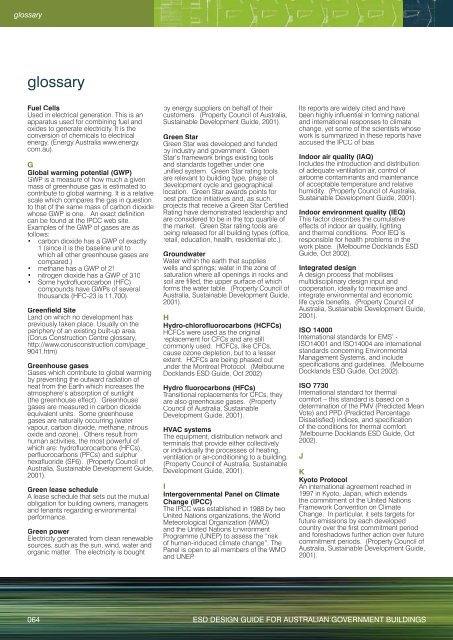
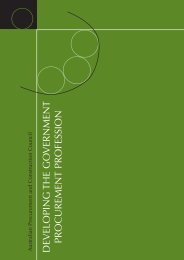
![NATIONAL COST ADJUSTMENT PROVISION EDITION 2 [NCAP2]](https://img.yumpu.com/48266135/1/184x260/national-cost-adjustment-provision-edition-2-ncap2.jpg?quality=85)
